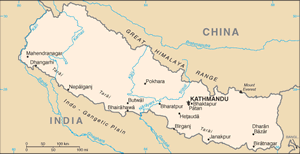The Geography of Nepal
The Geography of Nepal
Nepalese Geography
Location: Southern Asia, between China and India
Geographic coordinates: 28 00 N, 84 00 E
Map references: Asia
Area: total: 147,181 sq km land: 143,181 sq km water: 4,000 sq km
Area - comparative: slightly larger than Arkansas
Land boundaries: total: 2,926 km border countries: China 1,236 km, India 1,690 km
Coastline: 0 km (landlocked)
Maritime claims: none (landlocked)
Climate: varies from cool summers and severe winters in north to subtropical summers and mild winters in south
Terrain: Tarai or flat river plain of the Ganges in south, central hill region, rugged Himalayas in north
Elevation extremes: lowest point: Kanchan Kalan 70 m highest point: Mount Everest 8,850 m
Natural resources: quartz, water, timber, hydropower, scenic beauty, small deposits of lignite, copper, cobalt, iron ore
Land use: arable land: 16.07% permanent crops: 0.85% other: 83.08% (2005)
Irrigated land: 11,700 sq km (2003)
Natural hazards: severe thunderstorms; flooding; landslides; drought and famine depending on the timing, intensity, and duration of the summer monsoons
Environment - current issues: deforestation (overuse of wood for fuel and lack of alternatives); contaminated water (with human and animal wastes, agricultural runoff, and industrial effluents); wildlife conservation; vehicular emissions
Environment - international agreements: party to: Biodiversity, Climate Change, Climate Change-Kyoto Protocol, Desertification, Endangered Species, Hazardous Wastes, Law of the Sea, Ozone Layer Protection, Tropical Timber 83, Tropical Timber 94, Wetlands signed, but not ratified: Marine Life Conservation
Geography - note: landlocked; strategic location between China and India; contains eight of world's 10 highest peaks, including Mount Everest and Kanchenjunga - the world's tallest and third tallest - on the borders with China and India respectively


